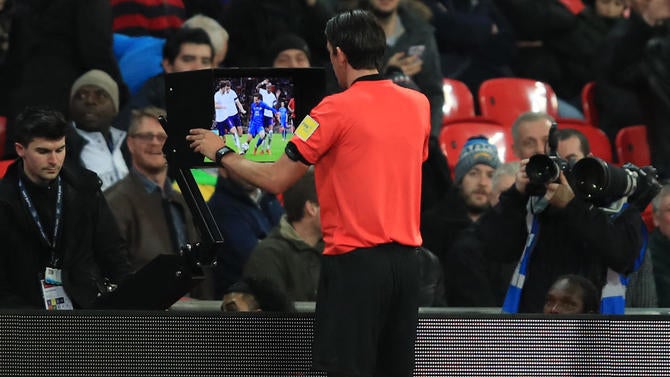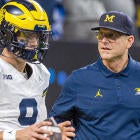This World Cup has a fun little wrinkle added to it. You may have noticed play stopping on occasion after controversial calls That's because this FIFA has added Video Assistant Referees, which is changing how soccer is officiated. And on Sunday during the World Cup final between Croatia and France in Moscow, the French team were awarded a penalty kick following a hand ball inside the box that was assisted by video replay.
El VAR aparece por primera vez en la final del #MundialTelemundo pic.twitter.com/dvpEiefHvN
— Telemundo Deportes (@TelemundoSports) July 15, 2018
Video Assistant Referees, better known as VAR, is making its FIFA World Cup debut this summer. It's a team of assistant officials removed from the on-field action, operating from a centralized video room in Moscow to help the head official on difficult calls. VAR is going to bring some changes to World Cup play, but only in an advisory capacity. At the end of the day, the head official will be the one making the decisions from the field. They're there to avoid game-altering mistakes, not micromanage the match.
Here are a few things you should know about VAR:
What plays are eligible for video review?
Goals and plays during the build-up to a goal: This one should be pretty obvious. Goals and, in particular, the moments preceding a goal will be reviewed. With soccer being the low-scoring game it generally is, it's essential to get these calls right. Therefore, infractions before a goal can be reviewed, as can the goal itself. This includes whether or not a ball went out of play, an offside, or a missed foul by an attacker that leads to a goal.
Penalty decisions and plays during the build-up to a penalty: With penalties having the capacity to completely swing a match, fouls that occur within the box will also be subject to review. Here's an example that we got on Saturday's match between France and Australia. The French side was awarded a penalty thanks to a replay decision in the second half of the match. Antoine Griezmann scored the PK which helped secure a 2-1 win in group stage play. It was the first time VAR was used to help the head official make a penalty call in the World Cup.
#MundialTelemundo ¡Por primera vez en la historia el VAR aparece en una Copa del Mundo y se marca penal para #FRA ! ¿Fue justa la decisión? pic.twitter.com/aTHhRcnZMj
— Telemundo Deportes (@TelemundoSports) June 16, 2018
VAR will take a look at if a penalty occurred and if it occurred in or out of the box. It will also look at offsides prior to penalties and if an attacking foul led to the penalty.
Direct red-card decisions: A direct red card not only serves as an ejection, but it also serves as a one-game suspension which is served the following match. For reference, think of this a bit like targeting in college football. The card will be given on the field, and then the play will be reviewed. If it's upheld, the offending player will be booted from the match, just like any other red card. Otherwise, it'll be enacted as a normal penalty. This will keep players on the pitch if a call looks worse in real-time than it actually is. Note: This will only apply to direct red cards, so if a player is kicked out for two yellows it will not be reviewable.
Mistaken identity: As rare as it is, mistaken identity can happen. That's when the wrong player is assessed a card or, worse, sent off from a match. Making this reviewable will allow officials to assess punishment to the proper players.
Offsides: If you're a casual fan, you're going to hear people yell this word a lot throughout June and July, and a lot of the time they'll be wrong. Offside is when an attacker (or forward) is past the last defender towards the opposing goal when a ball is struck. If you played in a rec league, it can be referred to as "cherry-picking." A player can be past the last defender, but only after a ball is hit.
This goes back to goals that can be reviewed, but offside is one of the trickiest calls in soccer to get correct. Different angles, if a line judge is even a step back of the action, can lead to missing an offside call. VAR will let officials go back with a superimposed offside line and look to see if a player broke at the proper time and was able to stay onside. Multiple angles for VARs will allow them to see if it's just a matter of perception causing a player to appear offside, or if he actually is. These calls come down to inches, so they need to be certain to call it one way or the other.
How does the referee signal a video review?
There are two signals that referees have to communicate that they're talking to VARs. The first way is informal, and is when the official is holding his hand up to his ear.
An official signal for video review looks like this:
Once that box signal is made, play stops and the official goes "to the booth," so to speak.
How does the review process work?
- Incident occurs
- Video assistant refs review the play and sends information to the head official
- Head official has three options: Accept the VAR information; review the information himself; come to a verdict.
VAR will, once again, be talking in the official's ear. They can then suggest that play is stopped if they see something off on the monitor. Once the official makes the box signal shown above, the VAR will communicate with and advise the official. After that step, the official can either take the VAR info at face value, reevaluate the call and look for himself, and then make a decision based on the information.
Is there an actual replay booth similar to other major American sports?
The referee review area, or RRA, is less a booth than it is a space. Found near the technical areas, it's a clearly marked area that contains a single mobile screen for the referee to look. The referee will be in contact with the VAR team throughout the review, but he won't disappear from sight.

Can the head ref and VAR disagree on a call?
VAR is going to have moments where it sees something different from the head official. Slow motion has that effect on calls. Ultimately, it's the head ref's call. When review is all said and done, the head official can accept or reject the information that the VAR gives him. In other words, he can either amend the call, or stay with what was called on the field. VARs are advisory, they are not the end-all be-all.
The VAR team is constantly monitoring the action, looking for plays worth bringing to the attention of the head official. Although most of what they're doing is watching passively, they will tell the official if a noteworthy play worthy of review comes up.
What kind of evidence is needed to overturn a call?
Although FIFA isn't specific about how calls will get overturned, the review will be used to rectify "clear and obvious errors" alongside "serious missed incidents." This is VAR's inaugural World Cup, and the hope is presumably that it will call the game better but won't mess with the flow of the game itself.
What kind of effect will VAR have on the length of matches?
VAR is being implemented with the intent of being as non-invasive as possible. That means that officials are going to work quickly and cohesively to make sure that these calls are corrected or confirmed in a timely manner. VAR may tack a few minutes onto stoppage time to make up for delays, but it shouldn't go on for extended periods of time.
Will this stop fans from critiquing calls made by officials?
Of course not. No one is ever happy with the way games are called, and the losing team always got a raw deal while, if you're on the winning team, "there were bad calls both ways." The fact is, VAR is being used to streamline matches and get more calls correct. No system is perfect, especially in a game such as soccer. But ultimately, soccer is feeling the pressure to embrace modern technology. No, fans won't be happy. It all comes down to getting the important calls right.
For a complete guide to VAR in Spanish, please visit our sister site, CNET.com.





















